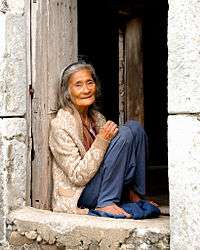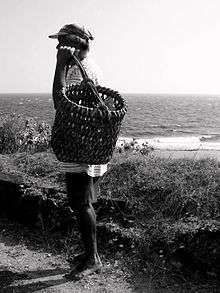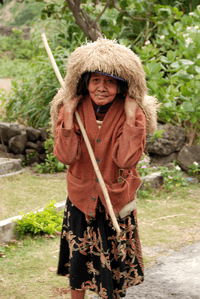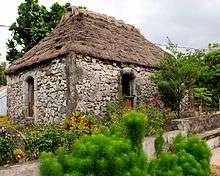Ivatan people
The Ivatans are a Filipino ethnolinguistic group predominant in the islands of Batanes of the Philippines. Their ethnogenesis is unclear; their origins remain untraced among scholars, but they are known to be an Austronesian group, related to neighboring Ilocanos on purely linguistic basis.
 An old Ivatan woman. | |
| Total population | |
|---|---|
| c. 24,500–50,000 | |
| Regions with significant populations | |
(Batanes) | |
| Languages | |
| Ivatan, Ilocano, Tagalog, English | |
| Religion | |
| Christianity (predominantly Roman Catholicism), minority also, ancestral worship | |
| Related ethnic groups | |
| Taiwanese aborigines, Ilocanos, other Austronesian peoples |
The culture of the Ivatans is partly influenced by the environmental condition of Batanes. Unlike the old-type nipa huts common in the Philippines, Ivatans have adopted their now-famous stone houses made of coral and limestone, designed to protect against the hostile climate.
Origins
Documents do not show much about the history of the Ivatans and at present, scholars who study their origins are still unsure as to their exact origin. They question whether the pre-historic Ivatans came from the northern part of Luzon or southern portions of China and Taiwan. There is evidence that they might be a surviving Christianized remnant of a people that once resided on all the islands between Luzon and Taiwan.[1] However, they have considered the close racial resemblance of the Ivatans to the Malays and the structure of their language could mean they came from other parts of the Philippines. Tracing their roots through Batanes' folklores, genetic studies of Omoto, a Japanese anthropologist, of the Yami of Orchid Island (Lanyu) show closer genetic affinity of the Yami to the Tagalog and Visayan and linguistically to the Batanic (Bashiic) sub-branch of the Malayo-Polynesian branch.[2]
History

Ivatans already lived in Batanes before the Spaniards arrived in the Philippines in the 16th century, establishing fortresses known as idjang, and lived autonomously long thereafter. On June 26, 1783, Batanes was incorporated to the Spanish East Indies.[1] In 1686, Ivatans were forced to settle in the lowlands of Batanes.[3] The Ivatans were under Spanish rule for 115 years, and gained their independence on September 18, 1898. However, June 6 is celebrated in Batanes as its founding day.[1]
Physical attributes
One of the earliest accounts of the Ivatan is that of the British buccaneer William Dampier in 1687. Dampier described them as "short, squat people; hazel eyes, small yet bigger than Chinese; low foreheads; thick eyebrows; short low noses; white teeth; black thick hair; and very dark, copper-colored skin."[2] They also have strong mixture of the short type of the Mongols, and there are some individuals who seem to have some physical characteristics peculiar to the Ainus of Japan.[1]
Demographics
In 1990, population of the Ivatans was 15,026, an increase of 24% over the 1980 population of 12,091. These were distributed to the six municipalities, with 38% residing in Basco, 23% in Itbayat, 12% in Sabtang, 11% in Mahatao and 8% for Uyugan and Ivana.[2] In the 2000 census, 15,834 Ivatans were among the 16,421 population in Batanes.[4]

The mother tongue of the Ivatans is the Chirin nu Ibatan, but is commonly known as Ivatan. A distinct Austronesian language, the Ivatan has two dialects including the Basco, the Itbayáten[6] and possibly the Yami.[1] The Ivatans widely speak and understand the Ilocano, Tagalog, and English languages.[2]
Today, most Ivatans are Catholics, like the rest of the country, although some have not converted and practice ancestral worship to their anitos.[1] However, there are growing Protestant denominations specially in Basco, the capital town of Batanes.[2]
Culture
The Ivatan's culture have been largely influenced by the climate of Batanes. Exposed to high risks of disruption to their agriculture, Ivatans have adopted strategies to live.
Traditionally, because of frequent typhoons and drought, they plant root crops able to cope with the environment. These crops include yam, sweet potato, taro, garlic, ginger and onion, as they ensure higher chances of survival during awry climate conditions.[7] The Ivatan study the behavior of animals, sky color, wind and clouds to predict the weather. Ivatans usually gather their animals and stay in their houses when they see that the cows take shelter from the payaman (communal pasture) and birds taking refuge in houses or in the ground. A pink sky with an orange hue also heralds a storm.[8]
The sea is vital to the Ivatan's way of life.[3] Although abundant only in the month of March to May, they depend on the flying fish (dibang) and dolphinfish (arayu) present on the shores of Batanes.[2] They have a native delicacy called uvod (the pith of the banana stalk) which is served, along with the wine palek, on festive occasions such as weddings.[1]
Before Spaniards arrived at the Philippines, Ivatans built their houses largely from cogon grass, small and well-situated, designed to protect against strong winds.[2][3] The Spaniards introduced large-scale production of lime for the construction of their now-famous stone houses. With meter-thick limestone walls,[3] the type of their infrastructures are designed against the harsh Batanes environment,[9] which is known as a terminal passage of typhoons in the Philippines. The basic cogon grass is still preserved as roofs of their houses, thickly constructed to withstand strong winds.[2] These houses are comparable to the white houses in New Zealand, Ireland and Scottish Highlands.[10]
One of the endemic clothing of the Ivatans is the vakul. A vakul is a headgear designed to protect the wearer from sun and rain. It is made from vuyavuy palm fiber.[3][5]
The Ivatan have three folk songs styles: the laji, the kanta and the kalusan.[2] The laji are ancient lyrical songs that are supposed to be sung when they are merry or just finished work.[11] The kalusan is sung during work.[2]
The Ivatan have legends that are called kabbata.[12] They have the rawod, chants that chronicle the adventures of the Ivatan's forefathers as they escape a disaster.[13]
See also
- Ivatan language
- Batanes
- Tao peoples
- Gaddang people
- Ibanag people
References
| Wikimedia Commons has media related to Ivatan people. |
- "Ethnic Profile: The Ivatan". National Commission on Indigenous Peoples. Archived from the original on March 11, 2008. Retrieved 2008-04-07.
- Datar, Francisco A. "The Batanes Islands". National Commission for Culture and the Arts. Retrieved 2008-04-06.
- Rowthorn, Chris (2003). Philippines. Lonely Planet. pp. 203. ISBN 1-74059-210-7. Retrieved 2008-04-06.
- "Population in Batanes Showed an Upward Swing". Philippine National Statistics Office. Archived from the original on 2008-04-03. Retrieved 2008-04-17.
- Madulid, Domingo A.; Agoo, Esperanza Maribel G. (2009). "Notes on the economic plants of Batanes: Citrus species and Phoenix loureiroi var. loureiroi". Bulletin of National Museum of Ethnology. 34 (1): 191–205. doi:10.15021/00003920.
- Galvez Rubino, Carl R. (2000). Ilocano Dictionary and Grammar. University of Hawaii. p. 213. ISBN 0-8248-2088-6. Retrieved 2008-04-06.
- Bankoff, Greg (2002). Cultures of Disaster: Society and Natural Hazards in the Philippines. Routledge. p. 165. ISBN 0-7007-1761-7. Retrieved 2008-04-06.
- Trinidad-Echavez, Andrea (2008-06-29). "Ivatan of Batanes share secrets of survival in typhoon belt". Philippine Daily Inquirer. Archived from the original on 2008-06-29. Retrieved 2008-07-01.
- Brown, Jessica; et al. (2005). The Protected Landscape Approach: Linking Nature, Culture and Community. The World Conservation Union. p. 103. ISBN 2-8317-0797-8. Retrieved 2008-04-06.
- Calubiran, Maricar. "Ivatan joins Dinagyang to promote Batanes tourism". The News Today. Retrieved 2008-04-17.
- Quindoza-Santiago, Lilia (2002). "Early Philippine Literature". National Commission for Culture and the Arts. Archived from the original on January 21, 2008. Retrieved 2008-04-07.
- "Ivatan/Itbayat". National Commission for Culture and the Arts. 2002. Archived from the original on January 21, 2008. Retrieved 2008-04-07.
- Espiritu, EV (2007-09-06). "'Tatayak' making keeps Ivatan seafarers alive". Philippine Daily Inquirer. Archived from the original on 2008-04-17. Retrieved 2008-04-07.

